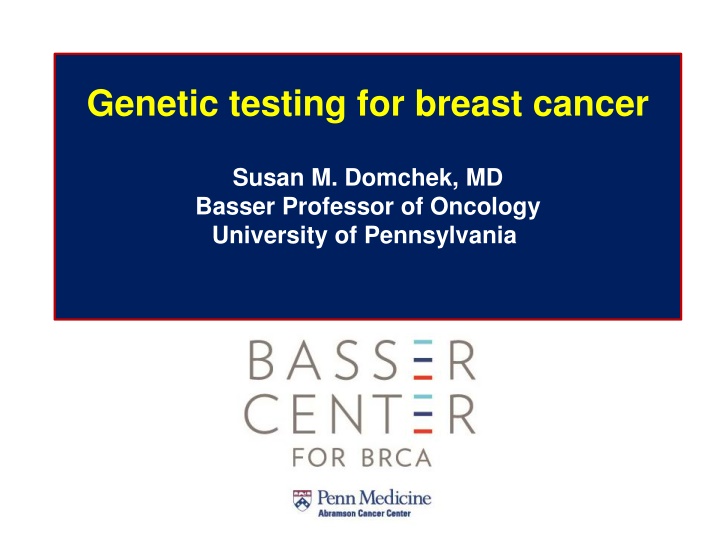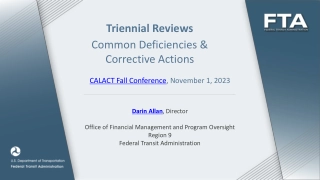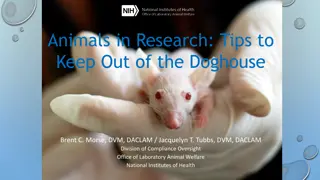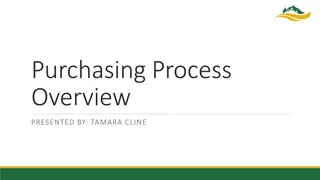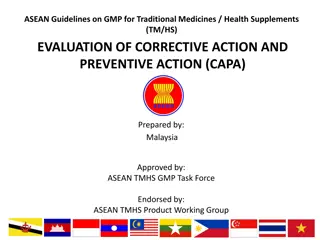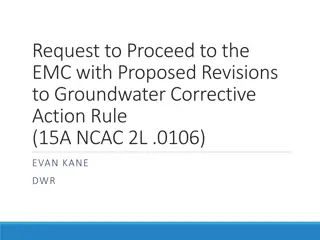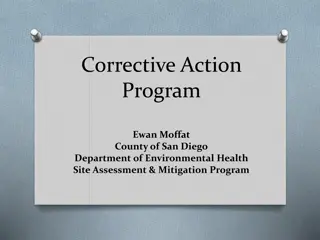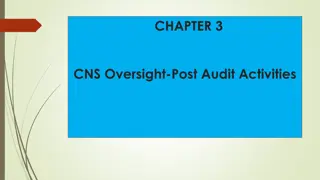Level 1 Assessment and Corrective Action
In the Revised Total Coliform Rule, a Level 1 assessment is triggered by specific treatment technique thresholds related to total coliform occurrence in public water supplies. This assessment involves a thorough examination of the water source, treatment process, distribution system, and operational practices to address any identified sanitary defects. Failure to conduct this assessment or rectify defects can lead to violations. The purpose of the assessment is to ensure the safety and quality of the public water supply by investigating vulnerabilities to contamination and remedying any sanitary issues found.
Download Presentation

Please find below an Image/Link to download the presentation.
The content on the website is provided AS IS for your information and personal use only. It may not be sold, licensed, or shared on other websites without obtaining consent from the author.If you encounter any issues during the download, it is possible that the publisher has removed the file from their server.
You are allowed to download the files provided on this website for personal or commercial use, subject to the condition that they are used lawfully. All files are the property of their respective owners.
The content on the website is provided AS IS for your information and personal use only. It may not be sold, licensed, or shared on other websites without obtaining consent from the author.
E N D
Presentation Transcript
Genetic testing for breast cancer Susan M. Domchek, MD Basser Professor of Oncology University of Pennsylvania
Risk Factors for Breast Cancer Sex Age Family history Depends on specific of family history Depends on whether there is a known genetic susceptibility Reproductive history Early first period Late last period Postmenopausal estrogen use Late first child No breast feeding ETOH Obesity Lack of exercise
Germline vs Somatic Genetics Germline the genes you are born with Can be passed on to relatives Does not mean that disease will happen Increased risk of disease There is no one breast cancer gene Somatic changes in tumors that are acquired over time Can not pass on to relatives Can be tested as part of decision making for therapy for cancer
Genetics :Cancer Risk Variants Single nucleotide polymorphisms Common Variants Allele Frequency CHEK2, ATM, NBN BRCA1, BRCA2, TP53 Rare variants (moderate) Rare variants (high) 1 2 5 10 Relative Risk
Hereditary breast cancer Predicted SNP , 14% Known SNPs, 14% Unknown, 50% Moderate penetrance , 4% Other high penetrance, 3% BRCA1/2, 15% Adapted from Couch, Nathanson, & Offit, Science 2014
Germline genetic testing as a paradigm for individualized care Risk Assessment Disease Prevention Therapeutics BRCA1/2 as the prototype
BRCA1/2-associated cancers: lifetime risk Breast cancer: 50%-70% Second primary breast cancer: 40%-50% Ovarian cancer: 15-55% BRCA1>BRCA2 Increased risk of other cancers: Male breast cancer Pancreatic cancer Prostate cancer Melanoma BRCA2>BRCA1 BRCA2 BRCA2 BRCA2
Who should be considered for testing? Breast cancer <45 Ovarian cancer cases (particularly high grade serous) Male Breast Cancer Breast and ovarian cancer in a single lineage 2 or more women with breast cancer <50 Ashkenazi Jewish with breast or ovarian cancer Breast cancer < 60 and triple negative Bilateral breast cancer <60 Pay attention to pancreatic cancer and high grade prostate cancer Ashkenazi Jewish individuals? All women at age 30? Many issues related to population screening
Estimates of breast cancer risk in BRCA1 carriers: Significant variability in penetrance 100% Easton, 1995 all mutations linkage families % Affected with Breast Cancer 90% 80% Penn Clinic Brose et al JNCI 2002 70% Streuwing, 1997 185delAG, 5382insC 60% 50% Hopper, 1999 consecutive breast ca cases 40% 30% Fodor, 1998 185delAG, 5382insC consecutive breast ca cases 20% 10% 0% 30 40 50 60 70 80 85 Age Age
Genetic modifiers: CIMBA 1.0 5%, 95% 10%, 90% Average Polygenic risk scores (PRS) using BC susceptibility SNPs identified through population-based GWAS BRCA1 carriers 0.8 Breast cancer risk 0.6 15,252 BRCA1 0.4 8,211 BRCA2 0.2 0.0 30 40 50 60 70 80 Age Kuchenbaecker et al in press 2016
Risk Reducing Salpingo-Oophorectomy and the risk of breast cancer No Prior Breast Cancer Total BRCA1 BRCA2 Total Participants 1,370 869 501 HR (95% CI) 0.54 (0.37-0.79) 0.63 (0.41-0.96) 0.36 (0.16-0.82) RRSO and the risk of ovarian cancer Breast cancer prior Total BRCA1 BRCA2 Total Participants 1060 684 376 HR (95% CI) 0.14 (0.04-0.59) 0.15 (0.04-0.63) No cancer events Domchek et al, JAMA 2010 PROSE Consortium
RRSO and all-cause mortality All eligible women All BRCA1 BRCA2 Total Participants 2,482 1587 895 HR (95% CI) 0.40 (0.26-0.61) 0.38 (0.24-0.62) 0.52 (0.22-1.23) Domchek et al, JAMA 2010 Domchek et al, JAMA 2010
Treatment of BRCA1/2-associated cancers: Platinum and PARP inhibitors Olaparib Veliparib Rucaparib Niraparib BMN-673 Poly ADP ribose polymerase (PARP) plays a role in the repair of single strand breaks through base excision repair Significant responses observed in patients with germline BRCA1/2- associated breast and ovarian cancer Tutt et al, Lancet 2010 Audeh et al, Lancet 2010 Gelmon et al, Lancet Oncology 2011
Tumor shrinkage Tutt et al, Lancet 2010
Approval is for germline BRCA1 and BRCA2 associated ovarian cancer after treatment with >3 lines of therapy The FDA did not approve maintenance therapy EMA did approve maintenance
Multiple tumor types Cisplatin-resistant ovarian cancer Breast cancer with >3 lines of therapy in metastatic setting Pancreatic and prostate cancer Kaufman et al, JCO 2015 Domchek et al, Gyn Onc 2016
Ovarian (n=193) Breast (n=62) Pancreas (n=23) Prostate (n=8) Other (n=12) All (n=298) BRCA status, n (%) BRCA1 mutation BRCA2 mutation Both 148 (76.7) 44 (22.8) 1 (0.5) 37 (59.7) 25 (40.3) 0 5 (21.7) 17 (73.9) 1 (4.3) 1 (12.5) 7 (87.5) 0 7 (58.3) 5 (41.7) 0 198 (66.4) 98 (32.9) 2 (0.7) Median (SD) prior regimens for advanced disease 4.3 (2.2) 4.6 (2.0) 2.0 (1.6) 2.0 (1.0) 2.2 (1.3) 4.0 (2.2) Tumor response rate 60 (31.1) 8 (12.9) 5 (21.7) 4 (50) 1 (8.3) 78 (26.2) Complete response 6 (3.1) 0 1 (4.3) 0 0 7 (2.3) Partial response 54 (28) 8 (12.9) 4 (17) 4 (50) 1 (8.3) 71 (23.8) Stable (>8wks) Stable disease Unconfirmed PR 78 (40) 64 (33) 12 (6) 29 (47) 22 (36) 7 (11) 8 (35) 5 (22) 3 (13) 2 (25) 2 (25) 0 7 (58) 6 (50) 1 (8.3) 124 (42) 99 (33) 25 (9) Kaufman et al JCO, 2015
Platinum resistance and PARP treatment Platinum sensitivity status (N= with measurable Confirmed responders n ORR, % (95% CI) Median DoR, months (95% CI) Data from the gyn onc paper disease) Total (N = 137) 34 (26 42) 7.9 (5.6 9.6) 46 Platinum sensitive (N = 39) 18 46 (30 63) 8.2 (5.6 13.5) Platinum resistant (N = 81) 24 30 (20 41) 8.0 (4.8 14.8) Platinum refractory (N = 14) 2 14 (2 43) 6.4 (5.4 7.4) Platinum status unknown (N = 3) 2 67 (9 99) 6.3 (4.7 7.9) Domchek et al, Gyn Onc 2016
Genetic testing has become complicated. Single nucleotide polymorphism panels
Key Points Not comprehensive sequencing of genes such as BRCA1/2 Not a stand alone for those with a strong family history Some change in reclassification (change in how you consider someone from a risk perspective) Calibration: How closely the predicted probabilities agree with the actual outcome Clinical utility (or actionability?) Will more women take tamoxifen? How should this impact screening in the era of changing screening recommendations? Ongoing studies
Ambry Cancer Next x x x x x Ambry Renal or PGL x x x x x x x x x x Ambry Cancer Next 28 x x x x x x x x x x x x x x x x x x x x x x x Myriad MyRisk Invitae GeneDxUwash Fulgent * Fulgent * Myriad MyRisk Invitae GeneDxUwash Fulgent * Gene Gene Gene BROCA BROCA BARD1 RAD51D MRE11A RAD50 NF1 VHL MEN1 RET PTCH1 PALLD XRCC2 CHEK1 AXIN2 FANCC ATR BAP1 GALNT12 HOXB13 POLD1 PRSS1 RAD51A SDHB SDHC SDHD AKT1 CTNNA1 FAM175A GEN1 GREM1 PIK3CA POLE PPM1D TP53BP1 x x x x x x x x x x x x x x x x x FH FLCN MAX MET MITF SDHA SDHAF2 TMEM127 TSC1 TSC2 x x x x x x x x x x # of genes APC ATM BMPR1A BRCA1 BRCA2 BRIP1 CDH1 CDK4 CDKN2A CHEK2 EPCAM MLH1 MSH2 MSH6 MUTYH NBN PALB2 PMS2 PTEN RAD51C SMAD4 STK11 TP53 25 x x x x x x x x x x x x x x x x x x x x x x x 28 x x x x x x x x x x x x x x x x x x x x x x x 30 x x x x x x x x x x x x x x x x x x x x x x x 50 x x x x x x x x x x x x x x x x x x x x x x x 110 x x x x x x x x x x x x x x x x x x x x x x x x x x x x x x x x Renal/PGL PGL x x x x x x x *Rest of genes on Fulgent: BLM, BUB1B, CTNNB1, CYLD, DDB2, DICER1, EGFR, EGLN1, ERCC2, ERCC3, ERCC4, ERCC5, EXO1, EXT1, EXT2, FANCA, FANCB, FANCD2, FANCE, FANCF, FANCG, FANCI, FANCL, FANCM, GPC3, HRAS, KIF1B, KIT, MC1R, MPL, MSH3, NF2, PDGFRA, PICALM, PMS1, PRKAR1A, PRKDC, PTPN11, RB1, RBBP8, RBM15, RECQL4, ROBO2, SBDS, SLX4, SMARCB1, SUFU, TERT, TSHR, TYR, WRN ,WT1, XPA, XPC, XRCC3 x x x x x x x x x x x x x x x x x x x x x x x x x x x x x x x Renal/PGL Renal/PGL Renal/PGL
Revolution of genetic testing Assess patient Test for most likely gene(s) Test for most likely gene(s) Disclose result and reassess
New approach? Assess patient Send multigene panel Disclose result and reassess
Why do this? More cost effective (for the testing) to do multigene rather than serial testing Patients (and providers!) can get testing fatigue The same cancer can be seen with different genes mutations Ovarian cancer in both BRCA1/2 and Lynch Uterine cancer in Lynch and Cowden Breast in Li-Fraumeni and BRCA1/2 Isn t more better?
Potential Issues High penetrance and moderate penetrance genes are on one panel Implications for counseling Keeping track of it all Don t we recognize clinical syndromes? (And if we don t what does it mean?) Variants of uncertain significance Clinical utility: order tests you will act on At least actionability Domchek et al, JCO 2013
What will we find? BRCA1/2 negative patients with BC <40 N=278 Patients with Class 4 VUS & Class 5 Mutations N=31 (11%) Class 3 VUS(s) only N=49 (18%) MUTYH Heterozygotes N=6 (2.2%)* No Class 3-5 Variants N=192 (69%) Bin A Genes Bin B Genes 6% TP53, PTEN, STK11, CDH1, CDKN2A, MLH1, MSH2, MSH6, PMS2, MUTYH (AR) Risk established for breast or other cancers Guidelines available *Clinically actionable* N=7 (2.5%) ATM, BARD1, BRIP1, CHEK2, FAM175A, MRE11A, NBN, PALB2, RAD50, RAD51C Risk established for breast and some other cancers Less clear actionability N=24 (8.6%) 13% 13% 31% 74% 63% White Non-white Class 4/5 Mutation No Class 3-5 Variants Class 3 VUS MUTYH N=1 TP53 N=4 MSH2 N=1 CDKN2A N=1 ATM & CHEK2 N=18 Other genes N=6 Maxwell et al GIM, 2014
What do we do? ACCE Framework Parameter Definition Analytic validity How well test measures property or characteristic it is intended to measure Accuracy of the test in diagnosing or predicting risk for the health condition (sensitivity, specificity, PPV, NPV) Evidence of improved measurable clinical outcomes Usefulness and added value to patient management Clinical validity Clinical Utility Ethical, legal and social implications ELSI
What is actionable? Something that potentially could be acted upon It does not mean that it is acted upon It does not mean that such action benefits a patient Actionability = clinical utility Critically important that all this be studied
Summary of Clinical Validity Gene Breast Ovary Other ATM Y N ?Pancreas CHEK2 Y N ?Colon PALB2 Y N ?Pancreas NBN Y (657del5) N BRIP1 N Y RAD51C/D N Y RAD51B N ? BARD1 N N MRE11A/RAD50 N N Easton et al, NEJM 2015
Clinical utility Risk assessment Value of the true negative Risk of breast and as well as risk of second primary cancer Risk of other cancers (Ovarian cancer risk for BRCA1/2 was a major reason for rapid uptake of testing)
Clinical utility Screening and prevention Need to understand risks and benefits What age to start screening? What screening? What age to have preventative surgery? What to do with unexpected high penetrance mutation When we find things we don t expect, what should we do?
Clinical utility Therapeutics Prognosis: may impact administration of adjuvant therapy Drug development/selection Will tumors with mutations in these other genes be sensitive to specific types of drugs?
Conclusions Genetic testing can be very useful to patients and their family members Both the prevent and to treat cancer Genetic testing is continuously evolving BRCA1 and BRCA2 mutations are the most commonly found and we have reasonable data on how to manage New genetics tests are often less clear in terms of how to change patients care and improve patient outcome Variants of unknown significance should NOT be managed as mutations In the face of rising prophylactic mastectomies, we need to emphasize to patients how mutations in these genes are different from those in BRCA1/2
